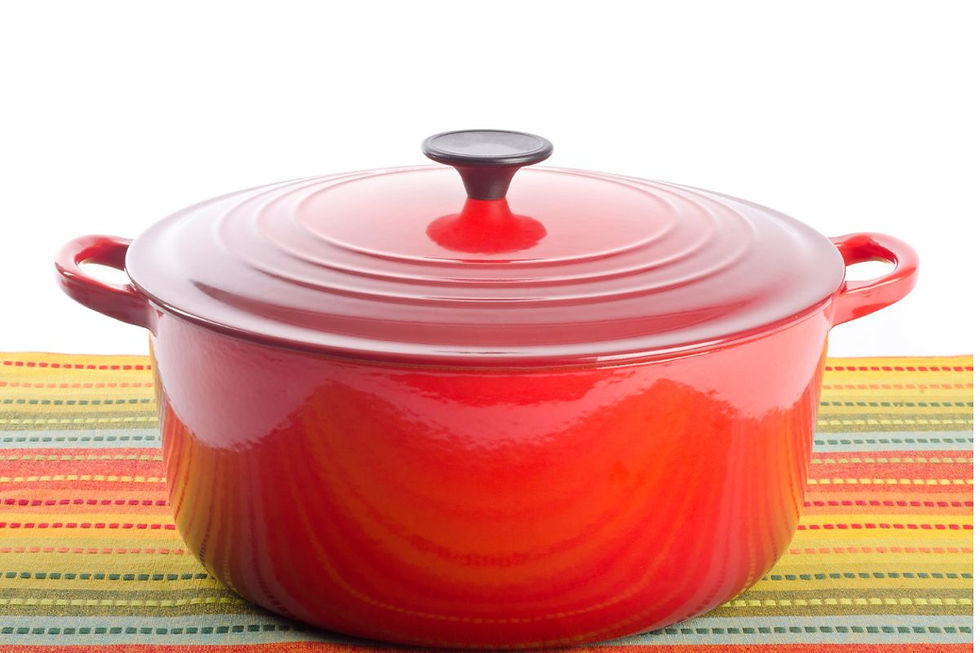Is Enameled Cast Iron Cookware Non-Toxic? What You Need to Know (2025 Guide)
- Our Editors – Zenda Guide

- Oct 4
- 4 min read
Updated: Oct 10

This post contains affiliate links. As an Amazon Associate, Zenda Guide earns from qualifying purchases at no extra cost to you. We only recommend trusted products that meet our quality standards. Learn more about how we work
A closer look at one of the most beloved—and misunderstood—materials in modern kitchens.
What Is Enameled Cast Iron and Why It’s So Popular
Enameled cast iron has earned a cult following among home cooks for good reason. It offers the even heat distribution of traditional cast iron, wrapped in a smooth, glass-like enamel coating that prevents rust and eliminates the need for seasoning.
This type of cookware is often praised for its durability, versatility, and beauty—moving seamlessly from stovetop to oven to table. But as more people seek non-toxic and safe materials for everyday cooking, many wonder: Is that colorful enamel coating actually safe?
Is Enameled Cast Iron Cookware Non-Toxic?
In short—yes, high-quality enameled cast iron is considered non-toxic and food-safe when produced by reputable manufacturers.
The enamel coating is made from powdered glass fused to the metal at very high temperatures. Once vitrified, it becomes inert, meaning it doesn’t react with food or leach chemicals the way nonstick coatings or low-grade metals can.
However, not all enamel cookware is created equal. Older or cheaply made products may use glazes that contain trace amounts of lead or cadmium for color. Reputable brands like Le Creuset and Staub rigorously test their products to meet strict FDA and Prop 65 standards, ensuring that their enamel coatings are lead-free and cadmium-free.
Tip: When shopping, look for labels that explicitly say lead-free enamel or reference California Prop 65 compliance.
→ For a full breakdown of safe materials, see our Non-Toxic Materials Guide.

Enameled Cast Iron vs Regular Cast Iron: What’s the Difference?
Both share the same heavy-duty cast-iron core—but their behavior in the kitchen is quite different.
Feature | Regular Cast Iron | Enameled Cast Iron |
Surface | Requires seasoning | Smooth, enamel-coated |
Maintenance | Can rust easily | Rust-resistant |
Reactivity | Reacts with acidic foods | Non-reactive |
Toxicity Risk | Safe but can leach iron | Inert glass surface |
Cleaning | Hand wash only | Easier to clean |
If you prefer a low-maintenance, non-reactive surface that still performs beautifully for slow cooking, enameled cast iron is the best of both worlds.
→ Compare other safe materials in our Best Non-Toxic Cookware Sets.
Enameled Cast Iron vs Nonstick Cookware: Which Is Safer?
While modern nonstick coatings have evolved, many still contain PFAS or other chemicals that can release harmful fumes at high heat. Enameled cast iron, by contrast, uses no synthetic coatings.
It’s heavier and takes longer to heat up, but once hot, it retains heat evenly—ideal for soups, stews, or baking bread. If you’re moving away from Teflon or ceramic-based nonstick pans, this material offers a durable, toxin-free alternative that can last decades.
→ Curious about coatings? Explore Air Fryer Materials 101: What to Avoid (and What’s Actually Safe).
What You Should (and Shouldn’t) Cook in Enameled Cast Iron
Enameled cast iron shines with slow-simmered dishes, sauces, braises, and baked meals.
But there are a few things to avoid:
✅ Ideal for:
– Soups, stews, curries
– Tomato sauces and acidic dishes (no reaction)
– Bread baking and casseroles
🚫 Avoid:
– Deep frying at very high temperatures (may discolor enamel)
– Scraping with metal utensils
– Sudden thermal shocks (going from fridge to hot oven)
If food sticks, it’s often due to insufficient pre-heating or using low-smoke-point oils. Stick to gentle oils like avocado or refined coconut for high-heat use.

How to Clean and Care for Enameled Cookware
Caring for enameled cast iron is simple:
Let it cool before washing—sudden temperature changes can crack enamel.
Use soft sponges and mild soap (no steel wool).
Soak with baking soda for tough stains.
Avoid stacking heavy pieces without padding.
It’s technically dishwasher-safe, but hand-washing will preserve its glossy finish longer.
A little mindfulness keeps your Dutch oven beautiful for decades.
→ See our Best Non-Toxic Bakeware for more safe, long-lasting kitchen materials.
Le Creuset vs Staub: Which Is Safer?
Both brands have near-perfect safety records. Le Creuset has been lead-free since the 1970s and provides detailed third-party test results. Staub, made in France, also uses glass-based glazes free from toxic metals.
The real difference lies in aesthetics and finish—Le Creuset’s bright enamel tends to be smoother, while Staub’s matte finish is slightly more resistant to chipping.
From a safety standpoint, both are excellent long-term investments in your kitchen.
→ Compare design and features in our Best Dutch Ovens 2025.
When to Replace Enameled Cast Iron
If the enamel becomes severely chipped—especially inside the cooking surface—it’s time to retire the piece. Small hairline cracks are mostly cosmetic, but deep chips can expose raw cast iron and lead to rusting.
Quality enamel cookware can last 20 + years with proper care, making it one of the most sustainable choices for conscious kitchens.
FAQs — Your Enameled Cast Iron Questions Answered
Does enameled cast iron need to be seasoned?
No. The enamel creates a naturally non-reactive surface that doesn’t require seasoning like raw cast iron.
Can enameled cast iron go in the dishwasher?
Yes, but hand-washing is best to preserve shine and prevent dulling.
What cannot be cooked in enameled cast iron?
Avoid super-high-heat deep frying and dry-cooking without oil—these can damage enamel over time.
What’s the best cleaner for enameled cast iron?
A mix of warm water and baking soda works well. Avoid bleach or abrasive scrubs.
Is Staub better than Le Creuset?
Both are safe and lead-free. Staub’s matte finish resists chipping slightly better; Le Creuset’s smooth surface cleans more easily.
Final Thoughts — Safe Cookware That Lasts a Lifetime
Enameled cast iron proves that performance and safety can coexist beautifully. When you choose well-made, lead-free cookware, you invest in your health and in pieces designed to last a lifetime—reducing waste and avoiding the cycle of cheap replacements.
→ Explore more trusted picks in our Non-Toxic Materials Guide or browse our Best Non-Toxic Cookware Sets.
If you enjoy thoughtful guides like this one, join our newsletter for slow, meaningful updates on conscious living, non-toxic finds, and sustainable inspiration—no clutter, just clarity.








Comments